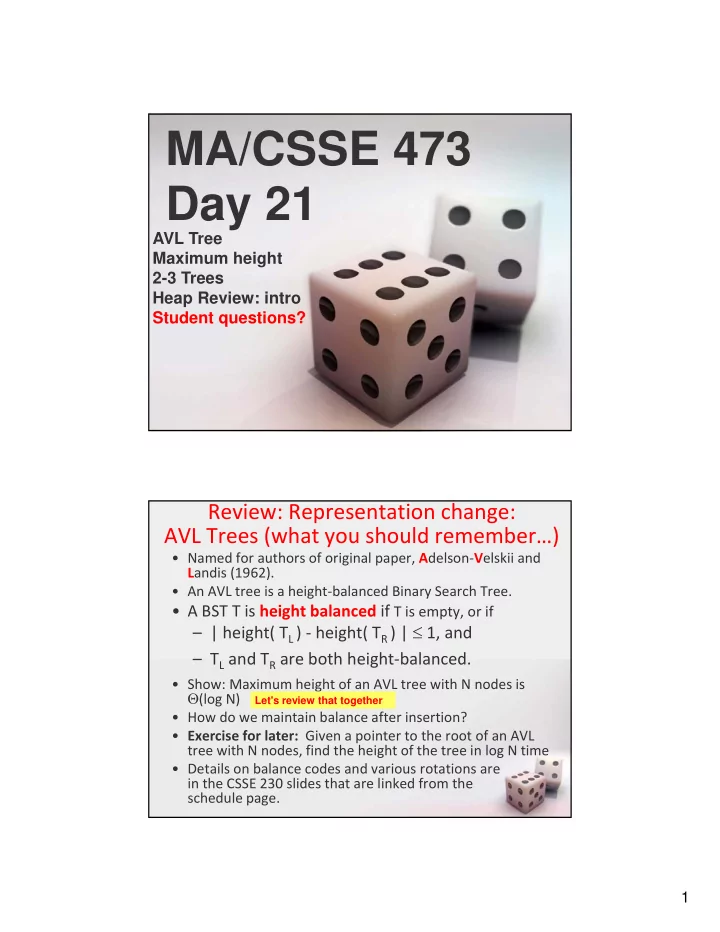

MA/CSSE 473 Day 21 AVL Tree Maximum height 2-3 Trees Heap Review: intro Student questions? Review: Representation change: AVL Trees (what you should remember…) • Named for authors of original paper, A delson ‐ V elskii and L andis (1962). • An AVL tree is a height ‐ balanced Binary Search Tree. • A BST T is height balanced if T is empty, or if – | height( T L ) ‐ height( T R ) | 1, and – T L and T R are both height ‐ balanced. • Show: Maximum height of an AVL tree with N nodes is (log N) Let's review that together • How do we maintain balance after insertion? • Exercise for later: Given a pointer to the root of an AVL tree with N nodes, find the height of the tree in log N time • Details on balance codes and various rotations are in the CSSE 230 slides that are linked from the schedule page. 1
Representation change: 2 ‐ 3 trees • Another approach to balanced trees • Keeps all leaves on the same level • Some non ‐ leaf nodes have 2 keys and 3 subtrees • Others are regular binary nodes. 2 ‐ 3 tree insertion example • More examples of insertion: http://www.cs.ucr.edu/cs14/cs14_06win/slides/2 ‐ 3_trees_covered.pdf http://slady.net/java/bt/view.php?w=450&h=300 Add 10, 11, 12, … to the last tree 2
Efficiency of 2 ‐ 3 tree insertion • Upper and lower bounds on height of a tree with n elements? • Worst case insertion and lookup times is proportional to the height of the tree. 2 ‐ 3 Tree insertion practice • Insert 84 into this tree and show the resulting tree 3
2 ‐ 3 Tree insertion practice • Insert 84 into this tree and show the resulting tree Binary (max) Heap Quick Review Representation change example See also Weiss, Chapter 21 (Weiss • An almost ‐ complete Binary Tree does min heaps) – All levels, except possibly the last, are full – On the last level all nodes are as far left as possible – No parent is smaller than either of its children – A great way to represent a Priority Queue • Representing a binary heap as an array: 4
Insertion and RemoveMax • Insertion: – Insert at the next position (end of the array) to maintain an almost ‐ complete tree, then "percolate up" within the tree to restore heap property. • RemoveMax: – Move last element of the heap to replace the root, then "percolate down" to restore heap property. • Both operations are Ѳ (log n). • Many more details (done for min ‐ heaps): – http://www.rose ‐ hulman.edu/class/csse/csse230/201230/Slides/18 ‐ Heaps.pdf Heap utilitiy functions Code is on-line, linked from the schedule page 5
HeapSort • Arrange array into a heap. (details next slide) • for i = n downto 2: a[1] a[i], then "reheapify" a[1]..a[i ‐ 1] HeapSort Code 6
Recap: HeapSort: Build Initial Heap • Two approaches: – for i = 2 to n percolateUp(i) – for j = n/2 downto 1 percolateDown(j) • Which is faster, and why? • What does this say about overall big ‐ theta running time for HeapSort? 7
Recommend
More recommend